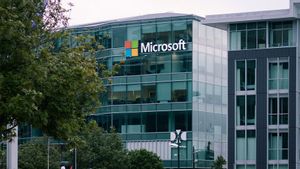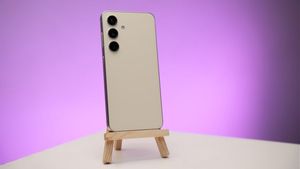JAKARTA – Early Friday, April 8, Florida time, SpaceX will launch a crew of four to the International Space Station from Florida. However, unlike most of SpaceX's passenger flights, the new program will not include current NASA astronauts.
All four crew members are civilians, flying with a commercial aerospace company called Axiom Space. Their flight will mark the first time a fully private crew has visited the ISS.
This is a new kind of human space mission and one that comes with a hefty price tag for its participants. Three of the four pamphlets have paid $55 million each for their seats in SpaceX's crew capsule, called Crew Dragon.
This trio of budding space explorers is Canadian investor Mark Pathy, American real estate investor Larry Connor and former Israeli Air Force pilot Eytan Stibbe. The commander of the trip was a space aviation veteran: Michael López-Alegría. He is a former NASA astronaut who has flown four missions into space and now serves as Vice President of Axiom.
Their mission, called Ax-1, is the latest in a trend of fully private astronaut flights into orbit. For most of the history of spaceflight, human spaceflight missions were carried out almost exclusively by government-run space programs.
All systems are looking good for tomorrow’s Falcon 9 launch of the @Axiom_Space Ax-1 mission to the @space_station; teams are keeping an eye on downrange weather along the ascent corridor. Webcast will go live at ~7:55 a.m. ET → https://t.co/N3MHSxCS0k pic.twitter.com/Tb76kDRQRz
— SpaceX (@SpaceX) April 7, 2022
But that trend is changing as the commercial aerospace industry has leaped forward over the past few decades. Leading the way is SpaceX, which has proven to be able to safely send people to and from low-Earth orbit with its Crew Dragon.
While SpaceX primarily launches NASA astronauts, the company has started flexing its muscles of late and has begun performing civil crew flights without NASA's input.
Civil aviation like this will become more common in the future. Axiom, which is seeking to build a commercial space station fleet, has scheduled three additional private crewed missions to the ISS, such as Ax-1, to prepare for the creation of its first station. Their goal is to "make spaces more accessible to everyone."
"This truly represents the first step in which a group of individuals who want to do something meaningful in low-Earth orbit, who are not members of the government, can take this opportunity," Mike Suffredini, Axiom CEO and former ISS program manager at NASA, said at the press conference. In fact, until costs can come down, such people will need a fat wallet to be able to do it.
New Paradigm
Axiom took advantage of some crucial times, as SpaceX transitioned into a new phase of operations with Crew Dragon. Initially, SpaceX developed Crew Dragon just for NASA to transport the agency's astronauts to and from the International Space Station. With the original contract valued at $2.6 billion and after more than six years of development, SpaceX successfully launched its first crew on Crew Dragon in May 2020, and sent two NASA astronauts to the ISS.
NASA's ultimate goal on this mission is to move transportation to the ISS to the private sector. But the second goal is for SpaceX to eventually use the capsule to carry out its own crewed missions.
Through the Axiom mission, SpaceX did: use the protocols and technology it developed for NASA to build a completely separate commercial business for human spaceflight.
Coinciding with the development of SpaceX's Crew Dragon was a major policy change at NASA. In 2019, NASA announced that it would be opening up facilities on the International Space Station for more commercial opportunities as well as encouraging private astronauts to visit the ISS on US spacecraft.
Such activities were previously discouraged, and although wealthy space tourists have visited the station before. They all flew on Soyuz rockets from Russia. Now, with this new change, people booking flights to the ISS on US spacecraft could potentially use the station's facilities for commercial activities, such as shooting movies or commercials.
SEE ALSO:
Of course, using the various ISS systems will come at a cost, just as if you were using the luxury facilities in a hotel. According to the agency's announcement, NASA plans to charge $1,250 per day per person to use the station's life support systems and toilets. They also provide supplies such as food, medical supplies, and exercise equipment which will cost a combined USD 22.500 (IDR 323 million) per day per person. This will be the most expensive “hotel” in space.
Currently, SpaceX is also working on building its first commercial space station, called the Axiom Station, with plans to eventually install the first modules of the orbiting outpost to the ISS in early 2024.
They plan to test the module on the ISS before it is abandoned and create a company-owned free-flying station. To prepare for this big move, Axiom turned to SpaceX to carry out a series of precursor missions to the ISS, which essentially became a series of rehearsals when Axiom sent people to its own space station one day.
"This precursor mission is important because we not only developed the techniques we will use to communicate ground-to-space here in mission control at Axiom, but we also developed all the procedures and processes that make spaceflight possible," said Peggy Whitson, former NASA astronauts, and director of human spaceflight at Axiom, as quoted by The Verge. Whitson himself will be the commander of Axiom's next mission, Ax-2.
The English, Chinese, Japanese, Arabic, and French versions are automatically generated by the AI. So there may still be inaccuracies in translating, please always see Indonesian as our main language. (system supported by DigitalSiber.id)















